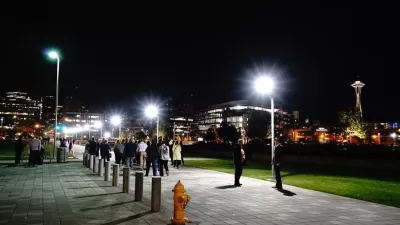If you run a google.com search for “The Death of Suburbia” you will find about 24,000 ‘hits.’ Some of the gloating over suburbia’s alleged demise is based on the facts that (some) suburbs have been hit hard by the current economic downturn, and that (some) city neighborhoods have become more expensive per square foot than than suburbs. (1) But suburbia as a whole continues to gain population.
If you run a google.com search for "The Death of Suburbia"
you will find about 24,000 ‘hits.' Some
of the gloating over suburbia's alleged demise is based on the facts that
(some) suburbs have been hit hard by the current economic downturn, and that
(some) city neighborhoods have become more expensive per square foot than than
suburbs. (1) But suburbia as a whole
continues to gain population.
How do we reconcile these realities? My visit to Tel Aviv last December gave me a
hint. Tel Aviv's population nosedived in the third quarter of the 20th
century (from 386,000 in the 1961 to 317,000 in 1988)(2) and then rebounded to
over 400,000 in the past two decades.(3)
But when I went to a small party in Tel Aviv, I learned that many of my
fellow guests (mostly thirty- and forty-something singles and couples) were
living in outlying suburbs because they were priced out of Tel Aviv – an
experience similar to my own in New York (insofar as I was priced out of
Manhattan and chose Queens instead).
Over the past couple of decades, some American regions have
become like Tel Aviv- places where urban life is more common, but less
affordable, than it once was. In the
1970s, city life was often something that well-off people fled from in disgust;
today, city life is often a luxury good – something that many well-off people
choose, and many slightly less well-off people wish they could afford. Instead of being the thrift store of American metropolitan
areas, the most urban parts of (some) cities have become the Neiman-Marcus of America.
Does this mean suburbia is "dead"? Of course not- any more than thrift stores (or
dollar stores or Wal-Mart) are dead.
Just as more people shop at Wal-Mart than at Neiman Marcus, more people
live and shop in suburbs than in cities.
But it does mean that policymakers are faced with a
different set of challenges than in, say, 1980.
Twenty or thirty years ago, one could more plausibly argue that it was a given that most Americans preferred suburbs to
cities, and public debate was about whether to accommodate this alleged preference or
to change it.
Today, it seems clear (at least to me) that there is not enough of urban life
to go around- that is to say, that more people want it than can afford it. So perhaps the debate should be over how to
create more of it, either by allowing more development in cities or by allowing
some suburbs to mimic the more desirable aspects of urban life.
(1) http://www.nytimes.com/2011/11/26/opinion/the-death-of-the-fringe-suburb.html

Planetizen Federal Action Tracker
A weekly monitor of how Trump’s orders and actions are impacting planners and planning in America.

Congressman Proposes Bill to Rename DC Metro “Trump Train”
The Make Autorail Great Again Act would withhold federal funding to the system until the Washington Metropolitan Area Transit Authority (WMATA), rebrands as the Washington Metropolitan Authority for Greater Access (WMAGA).

The Simple Legislative Tool Transforming Vacant Downtowns
In California, Michigan and Georgia, an easy win is bringing dollars — and delight — back to city centers.

The States Losing Rural Delivery Rooms at an Alarming Pace
In some states, as few as 9% of rural hospitals still deliver babies. As a result, rising pre-term births, no adequate pre-term care and "harrowing" close calls are a growing reality.

The Small South Asian Republic Going all in on EVs
Thanks to one simple policy change less than five years ago, 65% of new cars in this Himalayan country are now electric.

DC Backpedals on Bike Lane Protection, Swaps Barriers for Paint
Citing aesthetic concerns, the city is removing the concrete barriers and flexposts that once separated Arizona Avenue cyclists from motor vehicles.
Urban Design for Planners 1: Software Tools
This six-course series explores essential urban design concepts using open source software and equips planners with the tools they need to participate fully in the urban design process.
Planning for Universal Design
Learn the tools for implementing Universal Design in planning regulations.
Smith Gee Studio
City of Charlotte
City of Camden Redevelopment Agency
City of Astoria
Transportation Research & Education Center (TREC) at Portland State University
US High Speed Rail Association
City of Camden Redevelopment Agency
Municipality of Princeton (NJ)





























